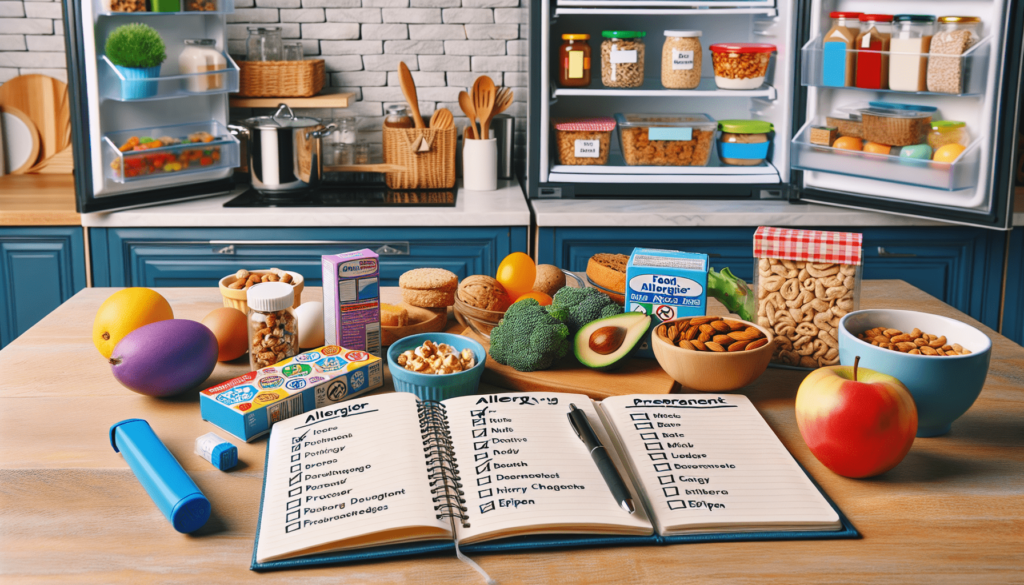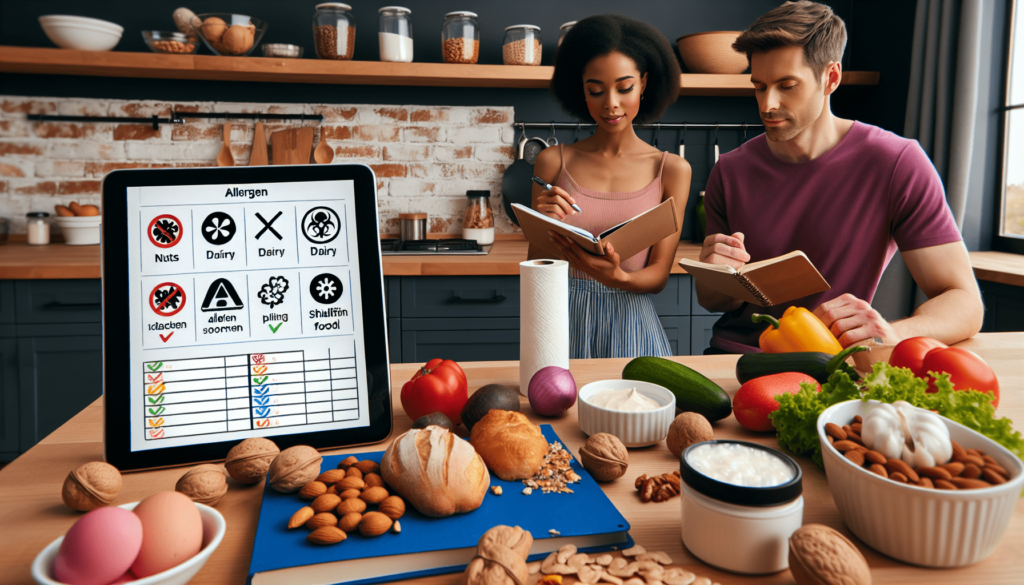Creating an effective food allergy action plan is essential for ensuring your safety and peace of mind when navigating the world with food allergies. This guide will walk you through each step you need to take, from identifying allergens to designing emergency response strategies, to make sure you’re well-prepared. Along the way, you’ll learn how to communicate your needs to others and integrate effective precautions into your daily routine, ultimately helping you live confidently and safely despite your food allergies. Have you ever worried about what would happen if someone you care about has a severe allergic reaction? Perhaps you’re a parent of a child with food allergies, or you have allergies yourself. These concerns are very real and valid. Crafting a well-rounded food allergy action plan could be the essential framework that brings peace of mind and potentially saves a life.
What is a Food Allergy Action Plan?
A Food Allergy Action Plan (FAAP) is a personalized document designed to improve the safety and management of individuals with food allergies. This plan provides clear instructions for recognizing symptoms of an allergic reaction and offers step-by-step guidance on how to respond effectively in case of an emergency. Its comprehensive nature makes it an invaluable resource for parents, caregivers, schools, and even workplaces.
Why You Need a Food Allergy Action Plan
Without a carefully thought-out plan, the risk of severe complications or even fatal outcomes increases dramatically. Allergic reactions can escalate rapidly, making quick and clear-headed action crucial. A FAAP serves as a preemptive measure, equipping everyone involved with the tools and knowledge needed to act swiftly and effectively.
Identifying the Allergens
The first step in creating an effective food allergy action plan is identifying the allergens. Knowing exactly which foods trigger allergic reactions allows you to take proactive steps to avoid them.
Common Food Allergens
According to various health organizations, the most common food allergens include:
| Food Category | Common Allergens |
|---|---|
| Dairy | Milk, cheese, yogurt |
| Nuts | Peanuts, tree nuts |
| Shellfish | Shrimp, crab, lobster |
| Fish | Tuna, salmon, cod |
| Eggs | Both egg whites and yolks |
| Soy | Soy sauce, tofu, miso |
| Wheat | Bread, pasta, cookies |
Testing for Food Allergies
If you’re unsure about which foods cause reactions, consult a medical professional for allergy testing. Skin prick tests, blood tests, and food challenge tests can help identify specific allergens. It’s better to have a clear picture of what you’re dealing with, to tailor your FAAP accordingly.

Communicating the Plan
Once you’ve identified the allergens, the next crucial step is effective communication. Everyone involved in the care of the person with allergies should understand the plan—from family members to teachers and even friends.
Sharing with Family and Friends
Start by educating your immediate circle. Explain the severity of the allergies, describe the symptoms, and provide clear instructions on what to do during a reaction. A laminated copy of the FAAP can be a handy reference for everyone involved.
Informing Schools and Workplaces
For children, it’s essential that teachers, school nurses, and other staff are aware of their food allergies. Adults with allergies should inform their employers and colleagues. Most institutions have protocols for managing allergies, but your personalized plan ensures nothing is overlooked.
Creating an Emergency Contact List
Make sure an emergency contact list is included within the FAAP. Include the contact information for:
- Parents/Guardians: If the plan is for a child.
- Primary Care Physician or Allergist: For professional medical advice.
- Emergency Services (911): Always a crucial number.
- Friends/Relatives Nearby: People who can help promptly.
Recognizing Symptoms of an Allergic Reaction
A significant part of your FAAP involves recognizing the symptoms of an allergic reaction early. Allergic reactions can range from mild to severe, with anaphylaxis being the most extreme and potentially life-threatening reaction.
Mild to Moderate Symptoms
Understanding the early signs can prevent severe reactions. Common mild to moderate symptoms include:
- Itchy or Runny Nose: Often mistaken for a cold.
- Hives or Rash: Localized skin reactions.
- Mild Coughing or Wheezing: Indicative of respiratory irritation.
- Mild Stomach Ache: Sometimes accompanied by nausea.
Severe Symptoms
Severe symptoms usually indicate that anaphylaxis may be setting in:
- Difficulty Breathing: Wheezing or straining to breathe.
- Swelling: Particularly of the lips, tongue, or throat.
- Drop in Blood Pressure: Dizziness or loss of consciousness.
- Rapid, Weak Pulse: Can indicate cardiovascular issues.
- Chest Pain: Severe reactions may mimic heart attack symptoms.

Steps to Take During an Allergic Reaction
Your FAAP should outline the exact steps to take in case of an allergic reaction, whether it’s mild or severe.
Mild to Moderate Reaction
- Administer Antihistamines: Over-the-counter or doctor-prescribed.
- Monitor the Symptoms: Keep an eye on how they evolve.
- Avoid Further Exposure: Remove any remaining allergens.
- Contact a Medical Professional: For additional advice and next steps.
Severe Reaction and Anaphylaxis
- Administer Epinephrine: Using an auto-injector like an EpiPen.
- Call Emergency Services (911): Always critical.
- Lay the Person Flat: Raise their legs unless it causes discomfort.
- Administer Second Dose of Epinephrine: If symptoms don’t improve in 5-15 minutes and another auto-injector is available.
- Transport to Emergency Room: Even if symptoms seem to improve, professional medical evaluation is crucial.
Storing Medication and Supplies
Your FAAP should also cover the proper storage and availability of medications and other essential supplies.
Essential Medications
- Epinephrine Auto-Injectors: Always carry at least two.
- Antihistamines: Both oral and topical varieties as needed.
- Inhalers: For anyone with related respiratory issues.
Safe Storage
- Accessibility: Keep medications easily accessible but out of reach of young children.
- Temperature Control: Store medications according to the manufacturer’s guidelines.
- Regular Checks: Ensure medication is within its expiry date and replace as necessary.
Training Care Providers
Your FAAP isn’t complete without proper training for everyone involved. Ensuring that all potential caregivers know how to use an epinephrine auto-injector can make a world of difference.
Formal Training Sessions
Arrange for formal training sessions through local healthcare providers. Many hospitals and organizations offer these for free or at a low cost.
Informal Training
Make time for informal sessions where you practice the steps outlined in the FAAP. Utilize training devices or video resources to demonstrate proper techniques for using medications.
Reviewing and Updating the FAAP
Creating your FAAP is not a one-time task. Regularly reviewing and updating the plan is essential to ensure its ongoing effectiveness.
Annual Review
Make it a point to review the FAAP annually. Check for any changes in healthcare recommendations, medication updates, or new contact information.
Situational Review
Update your plan whenever significant life changes occur, such as starting a new job or moving to a new home. Each new environment may present different risks and require adjustments to your plan.
Feedback and Improvements
Incorporate feedback from everyone involved. Maybe a teacher noticed a need for clearer instructions or a family member found a particular step confusing. Make necessary revisions based on real-life experiences and constructive feedback.
Additional Precautionary Measures
While the primary focus is on immediate response, there are ancillary measures that can further minimize risk and ensure safety.
Safe Food Practices
Adopting safe food practices can prevent accidental exposure:
- Reading Labels: Train everyone to read food labels vigilantly.
- Safe Food Preparation: Avoid cross-contamination by using separate utensils and cookware.
- Dining Out Safely: Inform restaurant staff and don’t hesitate to ask about ingredient specifics.
Environmental Controls
Implement environmental controls to create safer spaces:
- Allergen-Free Zones: Designate certain areas like the kitchen as allergen-free.
- Regular Cleaning: Keep spaces clean to avoid accidental exposure.
- Education and Signage: Use signs to remind everyone of allergen-free zones.
Psychological Well-being
Managing food allergies can be stressful. Incorporating mental health strategies provides a balanced approach:
- Stress Management: Include techniques like deep breathing or mindfulness.
- Support Groups: Finding a community can make a big difference.
- Counseling: Professional guidance can help manage anxiety and stress related to allergies.
Crafting a Personalized FAAP Template
Creating a personalized template can be immensely helpful. Below is an example of what your FAAP could look like:
| Section | Details |
|---|---|
| Personal Information | Name, age, weight, photo |
| Emergency Contacts | Primary, secondary, tertiary contacts with phone numbers |
| Allergy Information | List of allergens with severity |
| Symptoms | Mild (itchiness, hives) and severe (difficulty breathing) |
| Action Steps | Detailed step-by-step for mild and severe reactions |
| Medication Instructions | How to use epinephrine, antihistamine dosages |
| Follow-up Care | Instructions after initial treatment, emergency room visit necessary |
| Additional Notes | Any other important information or instructions |
Frequently Asked Questions (FAQs)
What Should Go in My Child’s School Bag?
Besides the standard school supplies, ensure your child carries:
- Laminated copy of the FAAP
- Epinephrine auto-injector
- Antihistamines
- Emergency contact card
How Can I Make Restaurant Dining Safe?
When dining out, always inform the restaurant staff of the allergies. Choose eateries known for accommodating food allergies, and don’t hesitate to ask detailed questions about food preparation.
Can Allergies Develop Later in Life?
Yes, it’s possible to develop food allergies at any age. Regularly review and update medical tests and your FAAP to include any new allergies.
How Can Technology Help?
Mobile apps can serve as an additional resource for managing food allergies. Apps can help with reading labels, identifying allergens, and even offer emergency instructions.
Conclusion
Creating an effective food allergy action plan is not just a precaution; it’s an act of love and care. By taking the time to identify allergens, communicate the plan, recognize symptoms, and train caregivers, you are ensuring the well-being of yourself or your loved one. Regularly review and update your FAAP to reflect any changes, and incorporate feedback from your experience and those around you. With a well-crafted plan, you can face the challenges of food allergies head-on, armed with the knowledge and tools needed to manage any situation effectively. Your future self will thank you for taking these crucial steps today!
